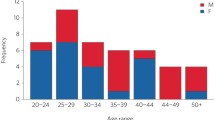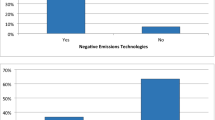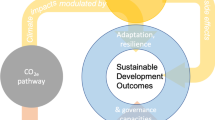Abstract
Solar radiation management (SRM) has been proposed as a potential method for reducing risks from global warming. However, a widely held concern is that SRM will not reverse the climate consequences of global warming evenly, resulting in regional disparities in the combined climate response to elevated greenhouse gas (GHG) concentrations and SRM. Recent research has used climate model projections to quantitatively assess how regional disparities affect the overall efficiency of global SRM and what the resulting potential for cooperation and conflict with regard to SRM may be. First results indicate that regional disparities, although present, may not be severe. These assessments rest on the assumption that, for all regions, any deviation from a past climate state inflicts damages. We challenge this strong change-is-bad assumption by showing that diverging preferences are not only plausible, but may also have the potential to substantially alter assessments of regional disparities. We argue that current assessments yield little information on the ethical and political implications of SRM and that diverging preferences should receive more attention. Promising directions for future inquiry include bridging gaps to the general climate impact research and to research on the social implications of environmental change.
Similar content being viewed by others
Notes
A detailed description of the illustrative model and the assessment framework can be found in the supplementary materials to this article.
References
Aaheim A (2015) An economic evaluation of solar radiation management. Sci Total Environ 532:61–69. doi:10.1016/j.scitotenv.2015.05.106
Ammann CM et al. (2010) Climate engineering through artificial enhancement of natural forcings: Magnitudes and implied consequences. J Geophys Res: Atmospheres 115. doi:10. 1029/2009JD012878
Arnell N. W. et al. A global assessment of the effects of climate policy on the impacts of climate change. Nat Clim Change, 3(5), 512–519. doi: 10.1038/nclimate1793
Ban-Weiss G.A., Caldeira K. (2010) Geoengineering as an optimization problem. Environ Res Lett 5(3). doi:10.1088/1748-9326/5/3/034009
Barrett S (2014) Solar geoengineering’s brave new world: thoughts on the governance of an unprecedented technology. Rev Environ Econ Policy. doi:10.1093/reep/reu011
Boucher O. et al. (2013) Clouds and aerosols. In: Climate Change 2013: The physical science basis. contribution of working group I to the fifth assessment report of the intergovernmental panel on climate change. Cambridge University Press
Boyd PW (2009) Geopolitics of geoengineering. Nat Geosci 2:812–812. doi:10.1038/ngeo710
Calzadilla A et al (2013) Climate change impacts on global agriculture. Clim Chang 120:357–374. doi:10.1007/s10584-013-0822-4
Castree N et al (2014) Changing the intellectual climate. Nat Clim Chang 4(9):763–768. doi:10.1038/nclimate2339
Emmerson C., Lahn G. (2012) Arctic opening: opportunity and risk in the high north. LLoyd’s
Ferraro A.J., Charlton-Perez A.J., Highwood E.J. (2014) A risk-based framework for assessing the effectiveness of stratospheric aerosol geoengineering. PLoS ONE 9. doi: 10.1371/journal.pone.0088849
Giorgi F, Francisco R (2000) Evaluating uncertainties in the prediction of regional climate change. Geophys Res Lett 27:1295–1298. doi:10.1029/1999GL011016
Govindasamy B, Caldeira K (2000) Geoengineering earth’s radiation balance to mitigate CO2-induced climate change. Geophys Res Lett 27:2141–2144. doi:10.1029/1999GL006086
Hulme M. (2011) Reducing the future to climate: a story of climate determinism and reductionism. Osiris 26. doi: 10.1086/661274
Hulme M. (2014) Can science fix climate change? Polity
IPCC (2013) Summary for policymakers. In: Climate Change 2013: The physical science basis. contribution of working group I to the fifth assessment report of the intergovernmental panel on climate change. Cambridge University Press
IPCC (2014) Summary for policymakers. In: Climate Change 2014: Impacts, Adaptation, and vulnerability. part A: global and sectoral aspects. contribution of working group II to the fifth assessment report of the intergovernmental panel on climate change. Cambridge University Press
Irvine P.J., Ridgwell A., Lunt D.J. (2010) Assessing the regional disparities in geoengineering impacts. Geophys Res Lett 37. doi: 10.1029/2010GL044447
Keith D. (2013) A case for climate engineering. MIT Press
Kravitz B et al (2011) The geoengineering model intercomparison project (GeoMIP). Atmos Sci Lett 12:162–167. doi:10.1002/asl.316
Kravitz B et al (2013) Climate model response from the Geoengineering Model Intercomparison Project (GeoMIP). J Geophys Res: Atmospheres 118:8320–8332. doi:10.1002/jgrd.50646
Kravitz B. et al. (2014) A multi-model assessment of regional climate disparities caused by solar geoengineering. Environ Res Lett 9. doi: 10.1088/1748-9326/9/7/074013
Lunt DJ et al. (2008) Sunshade world: a fully coupled GCM evaluation of the climatic impacts of geoengineering. Geophys Res Lett 35. doi: 10.1029/2008GL033674
MacMartin DG, Caldeira K, Keith DW (2014) Solar geoengineering to limit the rate of temperature change. Philos Trans Royal Soc London A: Mathematic, Phys Eng Sci 372(2031):20140134. doi:10.1098/rsta.2014.0134
Moreno-Cruz JB, Ricke KL, Keith DW (2012) A simple model to account for regional inequalities in the effectiveness of solar radiation management. Clim Chang 110:649–668. doi:10.1007/s10584-011-0103-z
Porter J.R. et al. (2014) Food security and food production systems. In: Climate change 2014: impacts, adaptation, and vulnerability. part A: global and sectoral aspects. contribution of working group II to the fifth assessment report of the intergovernmental panel on climate change. Cambridge University Press
Preston, C.J. (2012) Ethics and geoengineering: reviewing the moral issues raised by solar radiation management and carbon dioxide removal. Wiley Interdisciplinary Reviews: Clim Change 4. doi: 10.1002/wcc.198
Ricke KL, Morgan MG, Allen MR (2010) Regional climate response to solar-radiation management. Nat Geosci 3:537–541. doi:10.1038/ngeo915
Ricke K.L. et al. (2012) Effectiveness of stratospheric solar-radiation management as a function of climate sensitivity. Nat Clim Change 2(2). doi:10.1038/nclimate1328
Ricke KL, Moreno-Cruz J.B., Caldeira K. (2013) Strategic incentives for climate geoengineering coalitions to exclude broad participation. Environ Res Lett 8. doi: 10.1088/1748-9326/8/1/014021
Robock A (2008) 20 reasons why geoengineering may be a bad idea. Bull At Sci 64:14–18. doi:10.2968/064002006
Rosenzweig C et al (2013) The agricultural model intercomparison and improvement project (AgMIP): protocols and pilot studies. Agric For Meteorol 170:166–182. doi:10.1016/j.agrformet.2012.09.011
Royal Society (2009) Geoengineering the climate: Science, governance and uncertainty
Schneider SH (1996) Geoengineering: could or should we do it? Clim Chang 33:291–302. doi:10.1007/BF00142577
Serreze MC, Francis JA (2006) The arctic amplification debate. Clim Chang 76:241–264. doi:10.1007/s10584-005-9017-y
Stephenson SR, Smith LC, Agnew JA (2011) Divergent long-term trajectories of human access to the arctic. Nat Clim Chang 1:156–160. doi:10.1038/nclimate1120
Victor DG et al (2009) The geoengineering option: a last resort against global warming? Foreign Aff 88:64–76
Weitzman ML (2009) On modeling and interpreting the economics of catastrophic climate change. Rev Econ Stat 91:1–19. doi:10.1162/rest.91.1.1
Weitzman ML (2012) A voting architecture for the governance of free-driver externalities, with application to geoengineering. NBER Working Paper 18622
Wood R, Gardiner S, Hartzell-Nichols L (2013) Climatic change special issue: geoengineering research and its limitations. Clim Chang 121:427–430
Acknowledgments
We thank the editor, the managing editor and three anonymous referees for their comments and suggestions. We also thank Tobias Pfrommer and summer school participants at Harvard University and Heidelberg University for their valuable feedback.
Author information
Authors and Affiliations
Corresponding author
Electronic supplementary material
Below is the link to the electronic supplementary material.
ESM 1
(PDF 494 kb)
Rights and permissions
About this article
Cite this article
Heyen, D., Wiertz, T. & Irvine, P.J. Regional disparities in SRM impacts: the challenge of diverging preferences. Climatic Change 133, 557–563 (2015). https://doi.org/10.1007/s10584-015-1526-8
Received:
Accepted:
Published:
Issue Date:
DOI: https://doi.org/10.1007/s10584-015-1526-8




